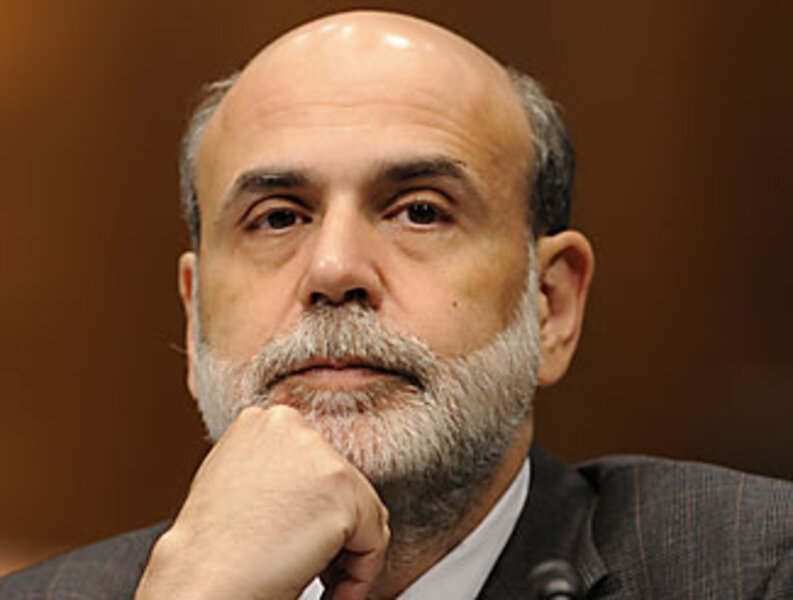Fed makes boldest move yet
Loading...
| New York
The Federal Reserve is now stepping in where financiers fear to tread.
In its latest move to unlock the credit markets, the nation's central banker said Tuesday it will take the extremely unusual step of buying short-term debt directly from America's largest corporations, such as GE, ExxonMobil, and Bank of America.
The Fed effort is one of the most dramatic – and potentially riskiest – steps Ben Bernanke, the chairman of the Fed, has taken in the past month in his effort to get credit flowing again through the economy. He is effectively pushing the Fed into the middle of the private market for short-term corporate loans, known as commercial paper. If it works, companies will have the loans they need to make payrolls and pay bills. If it doesn't, taxpayers could be on the hook for loans that aren't backed by any tangible assets.
The bold measure illustrates the seriousness with which the Fed chairman views the current credit crisis.
"This move shows the Fed is pulling out all the stops to restore confidence in this market," says Phil Flynn, director of research at Alaron Trading in Chicago.
In recent days the $100-billion-a-day market has been frozen as the nation's money-market funds, which usually buy the short-term funding, have stayed on the sidelines with huge quantities of cash.
Economists say the Fed is scrambling to keep the economic downturn from deepening.
"If other economic indicators were looking more positive, they would not be taking such dramatic steps," says Ann Owen, a professor of economics at Hamilton College in Clinton, N.Y., and a former economist at the Fed.
The new program caught the financial markets by surprise. On Monday, the markets had been expecting some sort of coordinated interest rate cut from the world's central banks. So far the only bank to do so is the Australian Reserve Bank.
"I guess the Fed is trying to keep that powder dry for as long as it can," says Mr. Flynn.
The next Federal Reserve meeting is at the end of the month. The financial markets already expect the central bank to lower interest rates by half a percentage point. Many economists expect to see rates drop again in December by another quarter of a percentage point.
“The outlook for economic growth has worsened,” Mr. Bernanke said in a speech at the annual meeting here of the National Association for Business Economics. "In the light of these developments, the Federal Reserve will need to consider whether the current stance of policy remains appropriate."
"The problem is if people are not lending, it does not matter what the target interest rate is," says Ms. Owen.
This is the second time the Fed has said it will deal directly with nonbanks. Last month, it announced it would lend directly to financially troubled AIG, one of the world's largest insurance companies. On Tuesday, when it announced its latest effort, the Fed invoked a Depression-era rule that it could lend under "unusual and exigent circumstances."
During the Great Depression, the Fed, in its role as lender of last resort, made loans to companies ranging from lumber companies to mercantile firms, according to the Federal Reserve Bank of Minneapolis. The effort continued for nearly 20 years.
Typically, the Fed deals only with member banks. "But these special powers give the Fed a blank check to go well outside of normal channels," says Bob Brusca of Fact and Opinion Economics in New York. "The Fed must see something that is real and threatening to the economy in a severe way."
In a statement, the US Treasury, which worked with the Fed on the effort, said the program "is necessary to prevent substantial disruptions to the financial markets and the economy." The Treasury will provide the money for the program, the Associated Press reported.
The locking up of credit markets has affected at least two states, California and Massachusetts, which have asked for government loans. Last week, GMAC pulled a $2.7 billion offering from its commercial finance unit when investors refused to buy it.
On Monday, in an effort to free up cash, the Federal Reserve said it would make $900 billion available for loans by year-end, an increase from $150 billion announced only two weeks ago. At the same time, the Fed said it would begin to pay interest on institutions' excess and required reserves. This will give the banks an additional source of profit.
Over the past several weeks, the Fed has had to become increasingly innovative. It has expanded the types of loans or securities it will accept as collateral. It has worked with other central banks to flood the markets with short-term cash to try to prevent the credit crunch from getting worse.
"It shows they are trying to be creative," says Flynn.
It's too soon to know if the creativity will get them in trouble. "The jury is out if they are just prolonging the pain," says Flynn. "The way business is going bankrupt, they may be at risk."
However, the issuers of commercial paper are usually top-tier companies. And the Fed plans to only buy securities that have a high rating.
"This facility should encourage investors to once again engage in term lending in the commercial paper market," the Fed said in a statement. The Fed's program will continue until April 30 of next year.
• Material from the Associated Press was used in this report.





